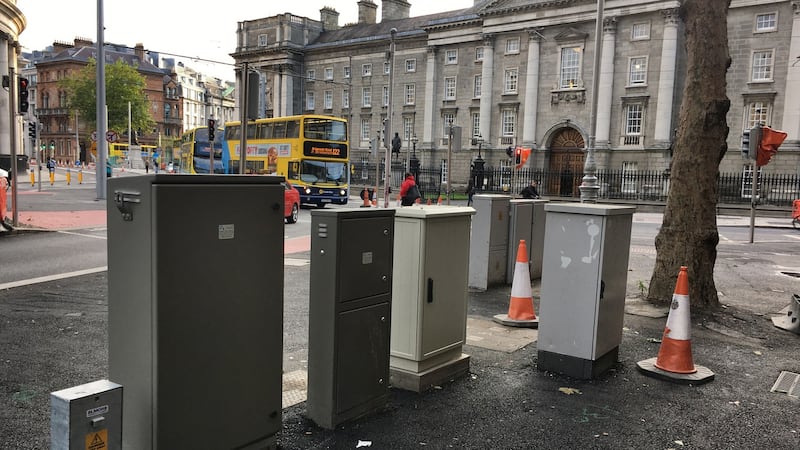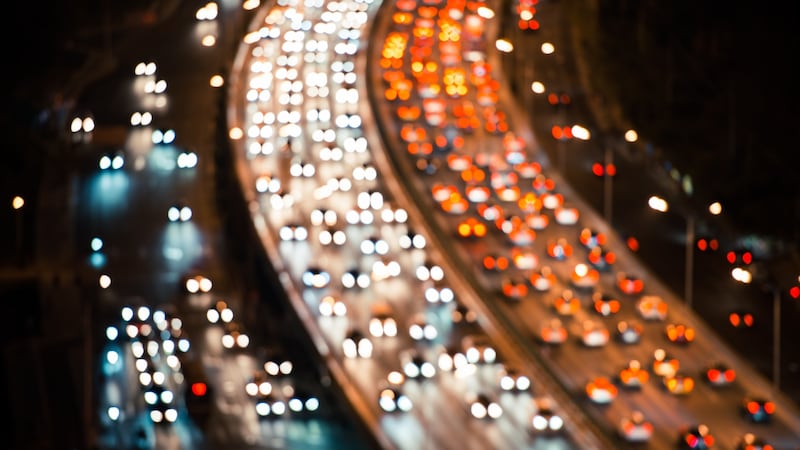De-clutter the streets
PAUL CULLEN, Irish Times journalist
Too often, Dublin feels like a slum. The roads are battered, buildings are badly maintained, the streetscape is cluttered. Bob Geldof wrote years ago about the impact the built environment can have on the psyche, and it's still the case that Dublin's deplorable landscape is dragging its citizens down unnecessarily.

We need to appoint an enforcer with special powers to ensure that roads are reinstated promptly and properly after being opened up; to de-clutter the streetscape (does every single sign need a separate pole?); and to have eyesores remedied and derelict buildings fixed or sold off.
Better footpath design
DEIRDRE BLACK, landscape architect
How we design streets determines how we move. How we move determines how we feel. The social realm of the city is anchored by its footpaths – it’s here the small-scale personal interactions happen with strangers and friends that form the glue that holds the whole thing together. Walking the city is a part of citizenship.
Most people’s feet work at 3mph and the rhythm of walking generates a rhythm of thinking and talking. To inhibit walking is to prevent thinking, and to stymie that precious Dublin commodity: conversation.
My “capital idea” is to pinpoint the locations in the city that are hostile to people walking. The physical infrastructure that keeps us human and humane is not expensive, or difficult to build. Studies have been carried out in Dublin to monitor heartbeat and adrenalin levels of walkers around the city. The places of highest anxiety are those where we are jolted out of what could be called “inattentive walking”.
Inattentive walking happens when the infrastructure around you enables movement without having to focus on not getting knocked down, bumped into, or jumped on. It means footpaths with an active building edge, smaller turning circles at junctions, appropriate widths and sensory markers, sensible location of bins, seats, trees, cycle racks. Conscious footpath design in other words.
Cities that respect the walker and their role as lifeblood to the city have great road crossings. Where pedestrian priority is not feasible, a green man light invites you to cross at regular intervals, with plenty of time to make the journey.
So let’s build great footpaths for the people, design for space and care, and make room for social interaction and city travel at 3mph.
Move Dublin Port
DAVID McWILLIAMS, Irish Times columnist
I have written this before but it is worth reiterating in the context of the Irish Times "Capital Ideas" series.
An obvious solution to Dublin’s capacity problem is to move our port and develop one of Dublin’s greatest natural assets into a new city. In the past three decades, Barcelona, Bremen, Copenhagen, Amsterdam, Oslo, Bilbao, Buenos Aires, Genoa, London and Cape Town have all moved their ports and liberated the land to create beautiful new cities in which people can work, live and play. Dublin is one of the hold-outs in still having a port on its most valuable prime land.
Ports no longer need to be at the mouths of rivers; it is people-based service industries that want to be close to amenities and to the sea. We have hundreds of acres of this land in Dublin, but it is full of massive oil drums and empty containers – a huge waste of development land.
Dublin Port management is doing a good job in managing trade in and out of the country; it's just that Dublin Port is in the wrong place. In a city with a massive housing and transport crisis, the opportunity cost of 640 acres of prime land occupied by a port that employs only 140 people is enormous. We could build 40,000 units there and still have over 220 acres for offices, shops, museums, sports facilities, parks, cafes, bars and clubs.
A clear solution to Dublin’s congestion, high rents and office capacity problems is to move Dublin port north, integrate the new port with the motorway system, and reclaim the entire area for high-density development. We could build a new Dublin on this land and create an entirely new city for the 21st century.
Transforming Dublin would take time but this is what great cities do: they build for the future with 100-year visions.
Straps in the right places
ORNA MULCAHY, Irish Times journalist
Heated bus shelters; free coffee days for pensioners; pop-up Christmas kiosks where they’d mind your shopping; launderettes in car parks and supermarkets: I can think of plenty of ways to make Dublin a better place to live in, but a simple strap to hang on to in rush-hour Dart trains would be a great start.
Most Darts have straps, but they’re either in the wrong place or at the wrong height. I find these are just a little too high for comfort, and why have them above the seating area and none in the stand-up open area where they’re needed?
In Japan’s famously jammed trains grab-handles come in jauntily-coloured rings, or elliptical shapes that can be used by two people at a time if you can bear a bit of hand-touching. A strap is a small thing but it would make life so much easier to have one that works and in the right place. Please.
Bus Rapid Transit
BARRY BOLAND, chartered surveyor and town planner working in the development industry
The February announcement by the Government of its intention to go ahead with the Metro Link tramline is a significant step towards creating a better public transport system in Dublin. Side by side with this system, the Bus Connects initiative has gone out to public consultation.
I argue that a third option – Bus Rapid Transit – offers a better solution for the simple reason that it is much cheaper.

Bus Rapid Transit consists of two carriages, articulated bus/trams with a seating capacity of 80 people and a further 80 standing at peak hours. It is rubber-wheeled and powered either by diesel or overhead electricity cables. It runs on a designated carriageway, on concrete plinths, with traffic-light priority at junctions. Waiting time signalling is standard, and its priority status means it can maintain an accurate timetable.
If Bus Rapid Transit looks like a tram, delivers service like a tram, and gives passenger comfort like a tram, then why is it so different? The simple answer is cost: both in terms of construction and the much reduced disruption time, particularly in congested Dublin streets. Bus Rapid Transit does not need the relocation of underground service pipes underneath its own carriageway – like Luas and Metro.
Bus Rapid Transit can be delivered at approximately €10 million per kilometre whereas Metro Link is likely to cost €100 million per kilometre (including land cost). For every Metro Link or Dart Underground we could have eight to 10 Bus Rapid Transit routes.
Compared with buses, the advantage of Bus Rapid Transit is more on the service side. The experience in Dublin reinforces international research whereby commuters are far more likely to abandon their cars in favour of trams rather than buses. This seems to have as much to do with image as with a reliable timetable.
As recently as 2014, the Dublin Transport Authority (DTA) published a Bus Rapid Transit proposal, which was open to public consultation but received little significant support. Around the same time, Dún Laoghaire Rathdown County Council proposed a Bus Rapid Transit from Merrion Gates to Sandyford. This also failed to garner any significant support.
It seems to me that transport planners in Dublin are not giving due consideration to Bus Rapid Transit, despite it being cheaper and arguably more attractive to customers than traditional bus lanes. I find it hard to fathom why. I urge the DTA to go to Nantes or Swansea to see what Bus Rapid Transit can deliver. I urge all other Dubliners to do the same.
Dog-exercising
ROSITA BOLAND, Irish Times journalist
Why not have a rail outside major supermarkets where you can tie your dog’s leash to, if you are a shopper out combining errands with exercising your dog. With someone in attendance who gives you a number, which you then return when you take your dog. You pay €1 for car parking at most supermarkets, and I’d happily pay the same to know someone was supervising my dog outside while I shopped unseen inside.
A home for nature
PADDY WOODWORTH, author, journalist, lecturer, tour guide
As well as connecting the city better to a better countryside, we need to bring more of the countryside into the city.
Here are six suggestions:
1. Cultivate urban agriculture, from tomato pots to allotments
2. Build upwards, not outwards, and include roof gardens and living walls into all new buildings.
3. Retain – and restore and create – natural corridors (streams and canals with all their vegetation, and hedgerows) between green spaces, so that plants and animals can move more freely around the city.
4. Prioritise native plants in gardens and parks, remove exotic invasive species, and where exotics are used, favour those that nurture pollinators.
5. Substitute wetlands for hard coastal armour wherever feasible.
6. Use permeable surfaces for cycleways and car parks, to minimise run-off.
Remove obstacles to kindness
JOE HUMPHREYS, Irish Times journalist
The idea of local government promoting civic virtue may seem weird today but it was an integral part of early democracy. The philosophers of ancient Athens recognised civility was a moral muscle that needed exercising. Dublin City Council could start with a mix of citizen juries for policy-making and the roll-out of programmes promoting good manners on the streets. More honesty boxes and volunteer banks, and less red tape for compassionate community initiatives, please.
The city of Anaheim in California (population 336,265) has made the promotion of kindness official policy (backed by luminaries including Lady Gaga). Initial results in tackling social isolation and crime have been encouraging. http://cityofkindness.org/
Beijing’s traffic strategy
CLIFFORD COONAN, Irish Times Beijing correspondent
With five million cars chugging along its streets, Beijing has been using the humble number plate as a weapon against congestion and air pollution.
While by most measures Dublin has a clear edge on the Chinese capital, traffic is becoming a problem. In March, 73 per cent of companies in the Dublin Chamber of Commerce said traffic in the city had negatively affected their businesses. Cars also accounted for more than half of emissions in 2016.

To fight congestion, Beijing has introduced a system to restrict the days you can drive in the city centre. On certain days, and depending on the final digit of your licence plate, you must refrain from driving in the city centre. For example, if the number plate on my car ends in 5, I can’t drive on Thursday.
Another way Beijing is trying to tackle congestion is by using an annual quota on issuing new number plates – and you can’t buy a car without securing a plate first. To get a plate you enter a bimonthly lottery – the odds of getting one are low.
China has little to teach Ireland about environmental protection, but it does have a strong record in introducing measures to slow congestion and air pollution, and has even started to reverse the trend in some areas.
It is an extreme measure, and Dubliners like their liberties, but it has made traffic-choked Beijing a little more liveable.
Ideas for a better Dublin: Share your suggestions
"Capital Ideas" is a series of Irish Times articles outlining ways we could improve Dublin city – its transport, economy and daily life. You can read them all at irishtimes.com/capitalideas.
Have you a proposal – big or small – that could make a real difference to the city and its citizens? We invite you to contribute to this series of articles using the form below. Your response may appear in The Irish Times or on irishtimes.com.












